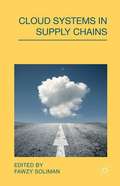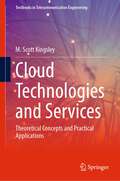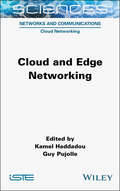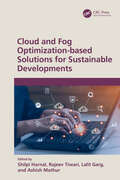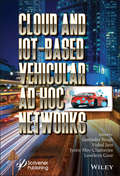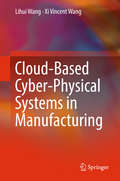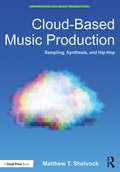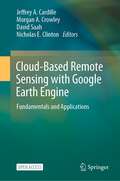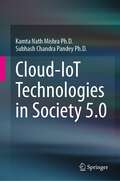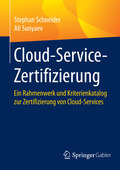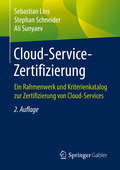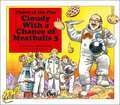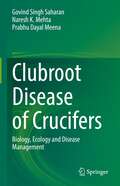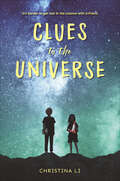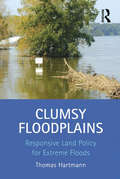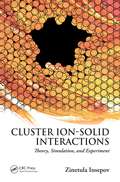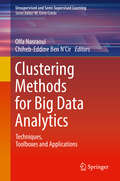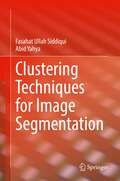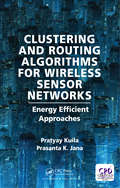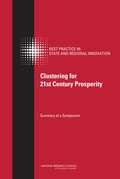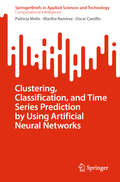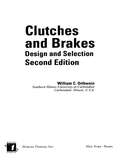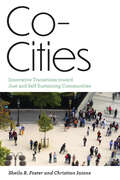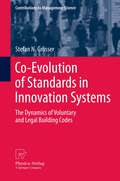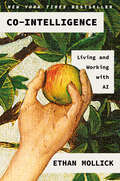- Table View
- List View
Cloud Systems in Supply Chains
by Alan Brown Mark Thompson Jerry FishendenCloud Systems in Supply Chains explores the risks that could face supply chain firms if their implementation of cloud systems is not carefully managed or if not appropriately selected and supported. This volume aids supply chain firms in ensuring that their cloud system activities are positioned to assist and sustain their competitive advantages.
Cloud Technologies and Services: Theoretical Concepts and Practical Applications (Textbooks in Telecommunication Engineering)
by M. Scott KingsleyThis textbook provides a thorough yet compact review of cloud technologies. It offers easy to understand explanations of the technical concepts underlying cloud services, platforms, and applications offered by Amazon Web Services (AWS), Microsoft Azure, and the Google Cloud Platform (GCP). It presents cloud concepts at a depth that can be understood and applied by both technical and non-technical readers. Once that is accomplished the learner can then easily move toward more advanced topics. Or, they can use the knowledge gained from this book to obtain industry certifications and be competitive in this exciting industry. Reader learning is enhanced with quizzes and exam questions and hands-on labs throughout the book with PowerPoint slides, instructor guide and additional labs online. All the tools needed for advancement to the level of cloud architect are found in this book. The author has verified the success of this approach in his own academic environment with much success. He teaches Cloud Engineering and Advanced Cloud Engineering at Southern Methodist University. Both courses were developed in partnership with the AWS Academy, the education arm of the Amazon Web Services cloud platform. Using this methodology his students routinely take and pass cloud certification exams and obtain lucrative employment positions in the rapidly expanding cloud industry.
Cloud and Edge Networking
by Guy Pujolle Kamel HaddadouA major transformation in the world of networks is underway, as the focus shifts from physical technology to software-based solutions. In this book, the authors present this new generation of networks that are based in the Cloud by detailing the transition from a complex environment to a simple digital infrastructure. This infrastructure brings together connected devices, the antennas that collect radio waves, the optical fibers that carry signals and the data center that handles all of the different processes. From this perspective, the data center becomes the brain, managing network services, controls, automation, intelligence, security and other applications. This architecture is relevant to carrier networks, the Internet of Things, enterprise networks and the global networks of the major Internet companies. Cloud and Edge Networking further discusses developments at the border of networks, the Edge, where data is processed as near as possible to the source. Over the next ten years, the Edge will become a major strategic factor.
Cloud and Fog Optimization-based Solutions for Sustainable Developments
by Rajeev Tiwari Lalit Garg Shilpi Harnal Ashish MathurCloud and Fog Optimization-based Solutions for Sustainable Developments discusses the integration of fog computing and the Internet of Things to provide scalable, secure, and cost-effective digital infrastructures for smart services in diverse domains: Highlights resource management solutions for the Internet of Things devices in fog computing architectures Discusses waste management using cloud and fog computing for sustainable development, and optimization of the Internet of Things in fog computing for fault tolerance Covers smart surveillance and monitoring using cloud and fog computing, and energy-efficient smart healthcare Explains energy-efficient frameworks for cloud-fog environments for sustainable development, and smart grid infrastructure using cloud and fog computing Presents the management of metropolitan mobility for public transport and smart vehicles with cloud and fog computing The text is primarily written for senior undergraduates, graduate students, and academic researchers in the fields of electrical engineering, electronics and communications engineering, computer science and engineering, and information technology.
Cloud and IoT-Based Vehicular Ad Hoc Networks
by Jyotir Moy Chatterjee Gurinder Singh Loveleen Gaur Vishal JainCLOUD AND IOT-BASED VEHICULAR AD HOC NETWORKS This book details the architecture behind smart cars being fitted and connected with vehicular cloud computing, IoT and VANET as part of the intelligent transport system (ITS). As technology continues to weave itself more tightly into everyday life, socioeconomic development has become intricately tied to ever-evolving innovations. An example of this is the technology being developed to address the massive increase in the number of vehicles on the road, which has resulted in more traffic congestion and road accidents. This challenge is being addressed by developing new technologies to optimize traffic management operations.This book describes the state-of-the-art of the recent developments of Internet of Things (IoT) and cloud computing-based concepts that have been introduced to improve Vehicular Ad-Hoc Networks (VANET) with advanced cellular networks such as 5G networks and vehicular cloud concepts. 5G cellular networks provide consistent, faster and more reliable connections within the vehicular mobile nodes. By 2030, 5G networks will deliver the virtual reality content in VANET which will support vehicle navigation with real time communications capabilities, improving road safety and enhanced passenger comfort.In particular, the reader will learn:A range of new concepts in VANETs, integration with cloud computing and IoT, emerging wireless networking and computing models New VANET architecture, technology gap, business opportunities, future applications, worldwide applicability, challenges and drawbacks Details of the significance of 5G Networks in VANET, vehicular cloud computing, edge (fog) computing based on VANET.AudienceThe book will be widely used by researchers, automotive industry engineers, technology developers, system architects, IT specialists, policymakers and students.
Cloud-Based Cyber-Physical Systems in Manufacturing
by Lihui Wang Xi Vincent WangThis book presents state-of-the-art research, challenges and solutions in the area of cloud-based cyber-physical systems (CPS) used in manufacturing. It provides a comprehensive review of the literature and an in-depth treatment of novel methodologies, algorithms and systems in the area of architecture design, cyber security, process planning, monitoring and control. The book features detailed descriptions of how to derive solutions in a cloud environment where physical machines can be supported by cyber decision systems when engaged in real operations. It presents a range of novel ideas and is characterized by a balanced approach in terms of scope vs. depth and theory vs. applications. It also takes into account the need to present intellectual challenges while appealing to a broad readership, including academic researchers, practicing engineers and managers, and graduate students. Dedicated to the topic of cloud-based CPS and its practical applications in manufacturing, this book benefits readers from all manufacturing sectors, from system design to lifecycle engineering and from process planning to machine control. It also helps readers to understand the present challenges and future research directions towards factories of the future, helping them to position themselves strategically for career development.
Cloud-Based Music Production: Sampling, Synthesis, and Hip-Hop (Perspectives on Music Production)
by Matthew T. ShelvockCloud-Based Music Production: Samples, Synthesis, and Hip-Hop presents a discussion on cloud-based music-making procedures and the musical competencies required to make hip-hop beats. By investigating how hip-hop producers make music using cloud-based music production libraries, this book reveals how those services impact music production en masse. Cloud-Based Music Production takes the reader through the creation of hip-hop beats from start to finish – from selecting samples and synthesizer presets to foundational mixing practices – and includes analysis and discussion of how various samples and synthesizers work together within an arrangement. Through case studies and online audio examples, Shelvock explains how music producers directly modify the sonic characteristics of hip-hop sounds to suit their tastes and elucidates the psychoacoustic and perceptual impact of these aesthetically nuanced music production tasks. Cloud-Based Music Production will be of interest to musicians, producers, mixers and engineers and also provides essential supplementary reading for music technology courses.
Cloud-Based Remote Sensing with Google Earth Engine: Fundamentals and Applications
by Jeffrey A. Cardille Morgan A. Crowley David Saah Nicholas E. ClintonThis book guides its audience—which can range from novice users to experts— though a 55-chapter tour of Google Earth Engine. A sequenced and diverse set of lab materials, this is the product of more than a year of effort from more than a hundred individuals, collecting new exercises from professors, undergraduates, master’s students, PhD students, postdocs, and independent consultants. Cloud Based Remote Sensing with Google Earth Engine is broadly organized into two halves. The first half, Fundamentals, is a set of 31 labs designed to take the reader from being a complete Earth Engine novice to being a quite advanced user. The second half, Applications, presents a tour of the world of Earth Engine across 24 chapters, showing how it is used in a very wide variety of settings that rely on remote-sensing data This is an open access book.
Cloud-IoT Technologies in Society 5.0
by Kamta Nath Mishra Ph.D. Subhash Chandra Pandey Ph.D.This book provides in-depth knowledge in the areas of convergence of cloud-IoT technologies and industry 4.0 with society 5.0, machine-to-machine communication, machine-to-person communication, techno-psychological perspective of society 5.0, sentiment analysis of smart digital societies, multi-access edge computing for 5G networks, discovery & location reporting of multi-access edge enabled clients/servers, m-health systems, enhancing the concert of M-health technologies in smart societies, supervising communication services in smart societies, life quality enhancement in smart city societies, multiple disease infection predictions, and societal opinion mining algorithms for smart cities societies using cloud-IoT integrated intelligent machine / deep learning technologies to the readers in the distributive environment. In this book, the authors have mandatorily discussed the implementation of cloud-IoT based machine learning technologies like clustering technique, Naïve Bayes classifier, artificial neural network (ANN), Firefly algorithm, Rough set classifiers, support vector machine classifier, decision tree classifier, ensemble classifier, random forest, and deep learning algorithms to analyze the behavior of intelligent machines and human habits using automated data scheduling and smart digital networks.At present, we live in a self-motivated and dynamic global society where technologies and challenges are unexpectedly changing overnight. These rapid changes in globalization and technological advances are creating new market forces every day. Therefore, day-to-day innovation is essential for any business or institution to survive and flourish in such an atmosphere. Though, innovation is no longer just to create value to do good to individuals, societies, or organizations. The utmost purpose of innovation is to create a smart futuristic society where people can enjoy the best quality of life using natural resources and manmade technologies including cloud-IoT technologies, and industry 4.0. Hence, the innovators and their innovations must search for intelligent solutions to tackle major socio-technical problems and remove barriers of rural, urban and smart city societies.The smart digitization and intelligent implementation of manufacturing development processes are the necessities for today’s rural, urban, and smart city industries. All types of industries including development, manufacturing, and research are presently shifting from bunch production to customized production. The fast advancements in manufacturing technologies have an in-depth impact on all types of societies including societies of rural areas, urban areas, and smart cities. Industry 4.0 includes the Internet of Things (IoT), Industrial Internet, Smart Manufacturing, Cloud-based computing, and Manufacturing Technologies. The objective of this book is to establish linkage between the Industry 4.0 components and various rural, urban & smart city societies (including society 5.0) to bring actual prosperity where human values, peace of mind, human relations, man-machine-relations, and calmness will have utmost preference. These objectives can be achieved by the integration of human societal values, and social opinion mining (SOM) approaches with the existing technologies.
Cloud-Service-Zertifizierung: Ein Rahmenwerk und Kriterienkatalog zur Zertifizierung von Cloud-Services
by Stephan Schneider Ali SunyaevDie Auslagerung von Services in die Cloud ist mit Risiken verbunden. Dieses Buch liefert ein Rahmenwerk zur Zertifizierung von Services in der Cloud. Herzstück dabei ist ein umfangreicher Kriterienkatalog zum Assessment von Cloud-Services. Dabei wendet sich das Buch an Cloud-Service-Anwender und unterstützt bei der Bewertung, dem Vergleich und der Auswahl von Angeboten. Gerade in kritischen Bereichen wie Sicherheit, Verfügbarkeit und Vertragsfragen unterstützt der Katalog bei der Definition von eigenen Anforderungen. Das Buch eignet sich jedoch auch für Cloud-Service-Anbieter, die es zum Self-Assessment und zur Verbesserung der eigenen Services nutzen können. Das Buch fasst eines der Ergebnisse des dreijährigen Forschungsprojekts ,,Value4Cloud" zusammen, das im Rahmen des Technologieprogramms ,,Trusted Cloud" vom Bundesministerium für Wirtschaft und Technologie gefördert wurde. Es liefert mit 219 Zertifizierungskriterien und einem Zertifizierungsrahmenwerk einen wichtigen Beitrag zum Assessment von Cloud-Services und der Verbesserung von Cloud-Service-Zertifizierungen.
Cloud-Service-Zertifizierung: Ein Rahmenwerk und Kriterienkatalog zur Zertifizierung von Cloud-Services
by Stephan Schneider Ali Sunyaev Sebastian LinsDieses Buch liefert ein Rahmenwerk zur Zertifizierung von Services in der Cloud. Herzstück dabei ist ein umfangreicher Kriterienkatalog zum Assessment von Cloud-Services, der im Forschungsprojekt „Value4Cloud“ , gefördert vom Bundesministerium für Wirtschaft und Technologie, entwickelt wurde. Cloud-Service-Anwender werden bei der Bewertung, dem Vergleich und der Auswahl von Services unterstützt. Das Buch eignet sich auch für Cloud-Service-Anbieter zum Self-Assessment und zur Verbesserung der eigenen Services.
Cloudy With a Chance of Meatballs 3: Planet of the Pies
by Judi BarrettWhen astronauts land on Mars, their first discovery is a substance not unlike pie filling, and Kate and Henry are eager to go taste some, but Grandpa, who may have some inside information, discourages them.
Clubroot Disease of Crucifers: Biology, Ecology and Disease Management
by Govind Singh Saharan Prabhu Dayal Meena Naresh K. MehtaThe book is presenting a comprehensive information on fundamental, and applied knowledge of Plasmodiophora brassicae Woronin. infecting cruciferous crops, and weeds. Clubroot of crucifers has spread over more than 88 countries of the world with average annual loss of cruciferous crops from 10-15 per cent at global level. It is considered as a disease of cultivation since once introduced in a field, its inoculum piles up year by year in the form of resilient resting spores of P. brassicae which spreads in the field through field operations. This disease is very unique since the pathogen can survive in the soil in the rhizosphere of non-host plants in addition to its main host cruciferous species, cultivated or wild. This book complies inclusive information about the disease, its geographical distribution, symptoms, host range, yield losses, and disease assessment scales. The book also explores host-parasite interactions in the form of seed infection, disease cycle, process of infection, pathogenesis, epidemiology and forecasting. Chapters discuss the genetic and molecular mechanisms of host-parasite relationships, management practices including cultural, chemical, biological control practices, and other integrated approaches. The book is immensely useful to researchers, teachers, extension specialists, farmers, and all others who are interested to grow healthy and profitable cruciferous crops all over the world. Also the book serves as additional reading material for undergraduate and graduate students of agriculture and especially plant pathology. National and international agricultural scientists, policy makers will also find this to be a useful read.
Clues to the Universe
by Christina LiThis stellar debut about losing and finding family, forging unlikely friendships, and searching for answers to big questions will resonate with fans of Erin Entrada Kelly and Rebecca Stead.The only thing Rosalind Ling Geraghty loves more than watching NASA launches with her dad is building rockets with him. When he dies unexpectedly, all Ro has left of him is an unfinished model rocket they had been working on together.Benjamin Burns doesn’t like science, but he can’t get enough of Spacebound, a popular comic book series. When he finds a sketch that suggests that his dad created the comics, he’s thrilled. Too bad his dad walked out years ago, and Benji has no way to contact him.Though Ro and Benji were only supposed to be science class partners, the pair become unlikely friends, and Ro even figures out a way to reunite Benji and his dad. But Benji hesitates, which infuriates Ro. Doesn’t he realize how much Ro wishes she could be in his place?As the two face bullying, grief, and their own differences, Benji and Ro try to piece together clues to some of the biggest questions in the universe.A Washington Post KidsPost Summer Book Club selection * A Junior Library Guild Selection * A Bank Street Best Book of the Year
Clumsy Floodplains: Responsive Land Policy for Extreme Floods
by Thomas HartmannExtreme floods cause enormous damage in floodplains, which levees cannot prevent. Therefore, it is vital for spatial planning to provide space for water retention in these areas. Land use planners, water management agencies, landowners, and policymakers all agree on this challenge, but attempts to make the space for rivers to provide retention are generally not very successful. Adopting an innovative interdisciplinary approach, this book examines how society can manage the use of the floodplains along rivers in the face of extreme floods, focusing in particular on the relation between social arrangements and the elemental forces of floods. The book firstly analyses why contemporary floodplain management is so often clumsy and ineffective by looking at various real-life situations in Germany, using Cultural Theory to provide a much-needed, but previously neglected social perspective. These analyses show a pattern of activity resulting from different rationalities which dominate the floodplains in different phases. During extreme floods, it is rational to manage floodplains as dangerous areas; sandbags and disaster management dominate the scene. After some time, the rationality of control takes over the floodplain management; policymakers discuss flood risk and water managers build levees. When public attention diminishes, floodplains become inconspicuous until more and more stakeholders regard floodplains as profitable land. The current system of planning, law, and property rights even encourages stakeholders to act out their plural rationalities. A permanent dynamic imbalance of different rationalities leads to a robust social construction of the floodplains which results in viable but clumsy floodplains. In the course of time, however, the patterns of activity in the floodplains lead to an increase in intensity and frequency of extreme floods, and to more vulnerable potential damages in the floodplains. Risk increases. Coping with this situation needs another kind of floodplain management. This book proposes an innovative concept - Large Areas for Temporary Emergency Retention (LATER) - in "Clumsy Floodplains" as an alternative to levee-based flood protection. The concept aims at reducing damage by extreme floods in a catchment area by inundating less valuable areas to protect places that are more valuable. It finally examines how this LATER concept might be implemented in areas where there is currently a clumsy style of floodplain management, what interventions are required and how these might come about effectively. Again, using Cultural Theory, the book puts forward a valuable land policy solution which aims at implementing LATER in clumsy floodplains and which develops an obligatory insurance against natural hazards as a responsive land policy for LATER. The book represents the author's PhD research, which he conducted as research assistant at the department for Land Policy, Land Management and Municipal Geoinformation at the School of Spatial Planning, TU Dortmund University, Germany.
Cluster Ion-Solid Interactions: Theory, Simulation, and Experiment
by Zinetula InsepovCluster Ion-Solid Interactions: Theory, Simulation, and Experiment provides an overview of various concepts in cluster physics and related topics in physics, including the fundamentals and tools underlying novel cluster ion beam technology. The material is based on the author's highly regarded courses at Kyoto University, Purdue University, the Mos
Clustering Methods for Big Data Analytics: Techniques, Toolboxes and Applications (Unsupervised and Semi-Supervised Learning)
by Olfa Nasraoui Chiheb-Eddine Ben N'CirThis book highlights the state of the art and recent advances in Big Data clustering methods and their innovative applications in contemporary AI-driven systems. The book chapters discuss Deep Learning for Clustering, Blockchain data clustering, Cybersecurity applications such as insider threat detection, scalable distributed clustering methods for massive volumes of data; clustering Big Data Streams such as streams generated by the confluence of Internet of Things, digital and mobile health, human-robot interaction, and social networks; Spark-based Big Data clustering using Particle Swarm Optimization; and Tensor-based clustering for Web graphs, sensor streams, and social networks. The chapters in the book include a balanced coverage of big data clustering theory, methods, tools, frameworks, applications, representation, visualization, and clustering validation.
Clustering Techniques for Image Segmentation
by Abid Yahya Fasahat Ullah SiddiquiThis book presents the workings of major clustering techniques along with their advantages and shortcomings. After introducing the topic, the authors illustrate their modified version that avoids those shortcomings. The book then introduces four modified clustering techniques, namely the Optimized K-Means (OKM), Enhanced Moving K-Means-1(EMKM-1), Enhanced Moving K-Means-2(EMKM-2), and Outlier Rejection Fuzzy C-Means (ORFCM). The authors show how the OKM technique can differentiate the empty and zero variance cluster, and the data assignment procedure of the K-mean clustering technique is redesigned. They then show how the EMKM-1 and EMKM-2 techniques reform the data-transferring concept of the Adaptive Moving K-Means (AMKM) to avoid the centroid trapping problem. And that the ORFCM technique uses the adaptable membership function to moderate the outlier effects on the Fuzzy C-meaning clustering technique. This book also covers the working steps and codings of quantitative analysis methods. The results highlight that the modified clustering techniques generate more homogenous regions in an image with better shape and sharp edge preservation.Showcases major clustering techniques, detailing their advantages and shortcomings;Includes several methods for evaluating the performance of segmentation techniques;Presents several applications including medical diagnosis systems, satellite imaging systems, and biometric systems.
Clustering and Routing Algorithms for Wireless Sensor Networks: Energy Efficiency Approaches
by Pratyay Kuila Prasanta K JanaWireless Sensor Networks have a wide range of applications in different areas. Their main constraint is the limited and irreplaceable power source of the sensor nodes. In many applications, energy conservation of the sensor nodes and their replacement or replenishment due to the hostile nature of the environment is the most challenging issue. Energy efficient clustering and routing are the two main important topics studied extensively for this purpose. This book focuses on the energy efficient clustering and routing with a great emphasis on the evolutionary approaches. It provides a comprehensive and systematic introduction of the fundamentals of WSNs, major issues and effective solutions.
Clustering for 21st Century Prosperity: Summary of a Symposium
by Charles W. WessnerResponding to the challenges of fostering regional growth and employment in an increasingly competitive global economy, many U. S. states and regions have developed programs to attract and grow companies as well as attract the talent and resources necessary to develop regional innovation clusters. These state and regionally based initiatives have a broad range of goals and increasingly include larger resources commitments, often with a sectoral focus and often in partnership with foundations and universities. Recent studies, however, have pointed out that many of these efforts lack the scale and the steady commitment needed for success. This has prompted new initiatives to coordinate and concentrate investments from a variety of federal agencies to develop research parks, business incubators, and other strategies to encourage entrepreneurships and high-tech development in the nation's regions. Understanding the nature of innovation clusters and public policies associated with successful cluster development is therefore of current relevance. Clustering for 21st Century Prosperity identifies best practices with regard to goals, structures, instruments, modes of operation, synergies across private and public programs, funding mechanisms and levels, and evaluation efforts. The committee, under the Board on Science, Technology, and Economic Policy (STEP) is reviewing selected state and regional efforts to capitalize on federal and state investments in areas of critical national needs. This review includes both efforts to strengthen existing industries as well as specific technology focus areas such as nanotechnology, stem cells, and advanced energy in order to better understand program goals, challenges, and accomplishments. As part of this study, the committee is convening a series of public workshops and symposia involving responsible local, state, and federal officials and other stakeholders. Drawing from discussions at these symposia, fact-finding meetings, and commissioned analyses of existing state and regional programs and technology focus areas, the committee will subsequently produce a final report with findings and recommendations focused on lessons, issues, and opportunities for complementary U. S. policies created by these state and regional initiatives.
Clustering, Classification, and Time Series Prediction by Using Artificial Neural Networks (SpringerBriefs in Applied Sciences and Technology)
by Oscar Castillo Patricia Melin Martha RamirezThis book provides a new model for clustering, classification, and time series prediction by using artificial neural networks to computationally simulate the behavior of the cognitive functions of the brain is presented. This model focuses on the study of intelligent hybrid neural systems and their use in time series analysis and decision support systems. Therefore, through the development of eight case studies, multiple time series related to the following problems are analyzed: traffic accidents, air quality and multiple global indicators (energy consumption, birth rate, mortality rate, population growth, inflation, unemployment, sustainable development, and quality of life). The main contribution consists of a Generalized Type-2 fuzzy integration of multiple indicators (time series) using both supervised and unsupervised neural networks and a set of Type-1, Interval Type-2, and Generalized Type-2 fuzzy systems. The obtained results show the advantages of the proposed model of Generalized Type-2 fuzzy integration of multiple time series attributes. This book is intended to be a reference for scientists and engineers interested in applying type-2 fuzzy logic techniques for solving problems in classification and prediction. We consider that this book can also be used to get novel ideas for new lines of research, or to continue the lines of research proposed by the authors of the book.
Clutches and Brakes: Design and Selection
by William C. OrthweinConveniently gathering formulas, analytical methods, and graphs for the design and selection of a wide variety of brakes and clutches in the automotive, aircraft, farming, and manufacturing industries, Clutches and Brakes: Design and Selection, Second Edition simplifies calculations, acquaints engineers with an expansive range of application, and a
Co-Cities: Innovative Transitions toward Just and Self-Sustaining Communities (Urban and Industrial Environments)
by Sheila R. Foster Christian IaioneA new model of urban governance, mapping the route to a more equitable management of a city&’s infrastructure and services.The majority of the world&’s inhabitants live in cities, but even with the vast wealth and resources these cities generate, their most vulnerable populations live without adequate or affordable housing, safe water, healthy food, and other essentials. And yet, cities also often harbor the solutions to the inequalities they create, as this book makes clear. With examples drawn from cities worldwide, Co-Cities outlines practices, laws, and policies that are presently fostering innovation in the provision of urban services, spurring collaborative economies as a driver of local sustainable development, and promoting inclusive and equitable regeneration of blighted urban areas. Identifying core elements of these diverse efforts, Sheila R. Foster and Christian Iaione develop a framework for understanding how certain initiatives position local communities as key actors in the production, delivery, and management of urban assets or local resources. Within this framework, they explain the forms such initiatives increasingly take, like community land trusts, new kinds of co-housing, neighborhood cooperatives, community-shared broadband and energy networks, and new local offices focused on citizen science and civic imagination. The &“Co-City&” framework is uniquely rooted in the authors&’ own decades-long research and first-hand experience working in cities around the world. Foster and Iaione offer their observations as &“design principles&”—adaptable to local context—to help guide further experimentation in building just and self-sustaining urban communities.
Co-Evolution of Standards in Innovation Systems: The Dynamics of Voluntary and Legal Building Codes (Contributions to Management Science)
by Stefan N. GrösserMitigating climate change is one of the most profound challenges facing humankind. In industrialized countries, the residential housing sector produces roughly one-fourth of the greenhouse gas emissions. One solution to reduce these emissions is the availability of building codes that require high levels of energy efficiency. Given the current scientific knowledge, more research is needed to gain a proper systemic understanding of the underlying socio-economic and technical system. Such an understanding is crucial for developing high energy-efficiency standards because this system develops gradually over time and cannot be changed swiftly. This book creates a feedback-rich simulation model for analyzing the effects of different administrative policies on energy demand, the improvement of energy efficiency by means of building codes, and reductions in the greenhouse gas emissions. The dynamic model can contribute substantially to the discourse on energy policies and guide effective administrative interventions. The book will be a valuable resource for officials in the public energy administration, as well as researchers in the areas of innovation, diffusion processes, co-evolution, standardization, and simulation modelling.
Co-Intelligence: Living and Working With AI
by Ethan MollickFrom Wharton professor and author of the popular One Useful Thing Substack newsletter Ethan Mollick comes the definitive playbook for working, learning, and living in the new age of AI <p><p> Something new entered our world in November 2022 — the first general purpose AI that could pass for a human and do the kinds of creative, innovative work that only humans could do previously. Wharton professor Ethan Mollick immediately understood what ChatGPT meant: after millions of years on our own, humans had developed a kind of co-intelligence that could augment, or even replace, human thinking. Through his writing, speaking, and teaching, Mollick has become one of the most prominent and provocative explainers of AI, focusing on the practical aspects of how these new tools for thought can transform our world. <p><p> In Co-Intelligence, Mollick urges us to engage with AI as co-worker, co-teacher, and coach. He assesses its profound impact on business and education, using dozens of real-time examples of AI in action. Co-Intelligence shows what it means to think and work together with smart machines, and why it’s imperative that we master that skill. <p><p> Mollick challenges us to utilize AI’s enormous power without losing our identity, to learn from it without being misled, and to harness its gifts to create a better human future. Wide ranging, hugely thought-provoking, optimistic, and lucid, Co-Intelligence reveals the promise and power of this new era. <p> <b>New York Times Bestseller</b>
